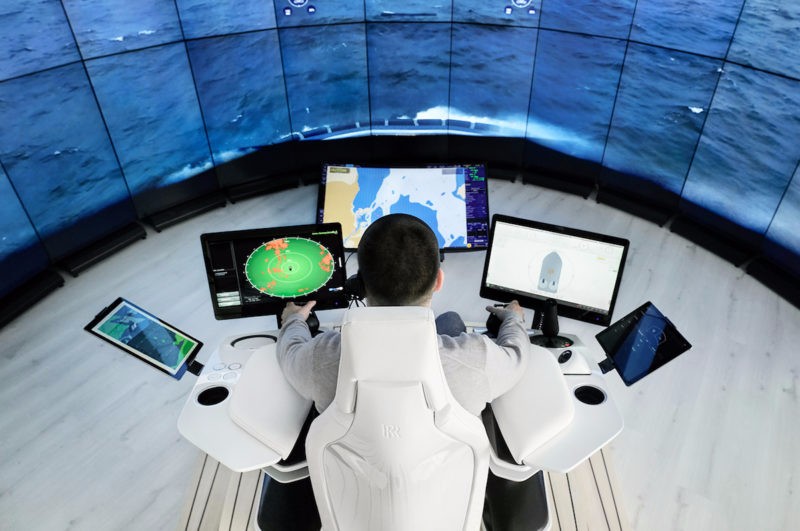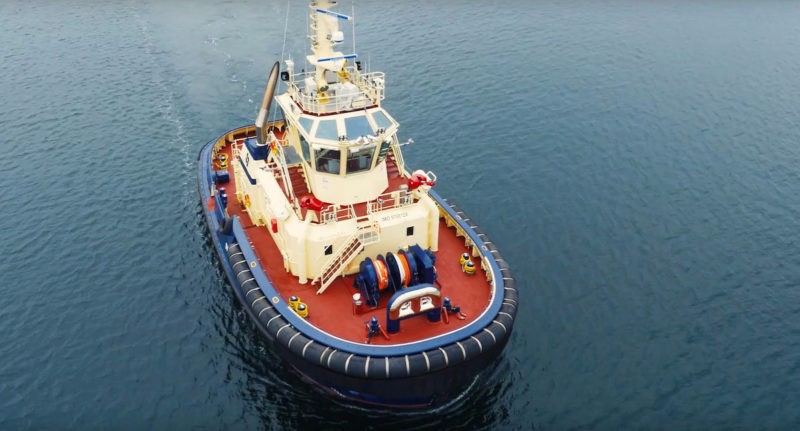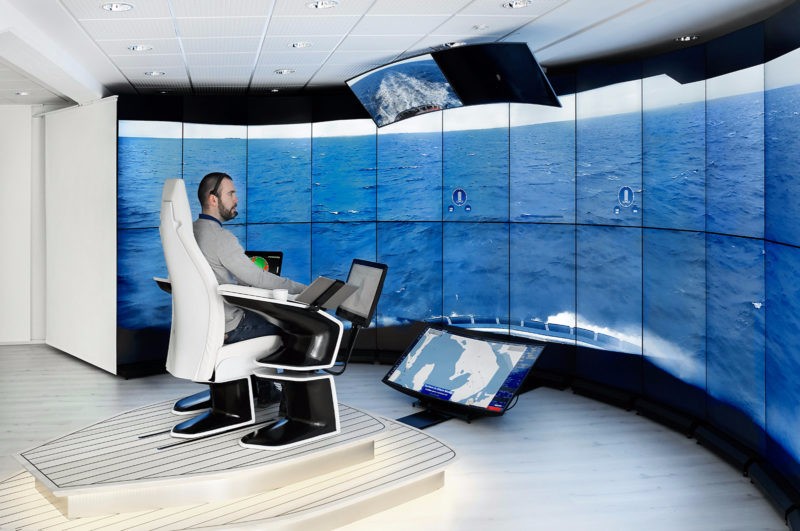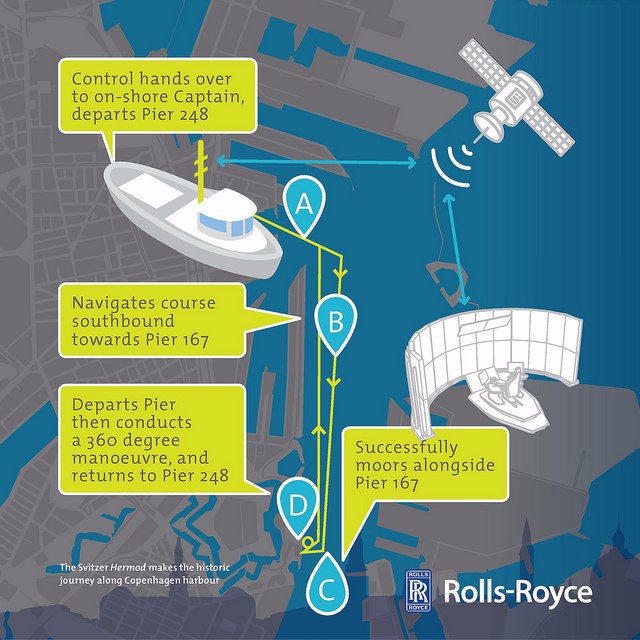 June 20, 2017 by gCaptain2
June 20, 2017 by gCaptain2
The shoreside “Captain’s chair” at Rolls-Royce’s Remote Operating Centre at Svitzer headquarters. Image credit: Rolls-Royce
Rolls-Royce and global towage operator Svitzer have demonstrated what is believed to be the world’s first remotely operated commercial vessel, Svitzer Hermod, in Copenhagen, Denmark, Rolls-Royce said Tuesday.
During the demonstration earlier this year, the 28-meter-long tugboat safely conducted a number maneuvers in Copenhagen harbor while controlled by a Captain ashore. From the quayside in Copenhagen harbor, Svitzer Hermod’s captain, stationed at a remote base at Svitzer headquarters, berthed the vessel alongside the quay, undocked, turned 360 degrees, and piloted it back to the Svitzer headquarters, before docking again.
 Svitzer Harmod. Image credit: Rolls-Royce
Svitzer Harmod. Image credit: Rolls-RoyceThe Svitzer Hermod, a Robert Allan ship design, was built in Turkey at the Sanmar yard in 2016. It is equipped with a Rolls-Royce Dynamic Positioning System, which Rolls-Royce describes as the key link to the remote controlled system. The vessel is also equipped with a pair of MTU 16V4000 M63 diesel engines from Rolls-Royce, each rated 2000 kW at 1800 rpm.
Rolls-Royce says Svitzer Hermod features a range of sensors which combine different data inputs using advanced software to give the captain an enhanced understanding of the vessel and its surroundings. The data is then transmitted to a Remote Operating Centre (ROC), where the Captain controls the vessel from.
The ROC was designed to redefine the way in which vessels are controlled, according to Rolls-Royce. Instead of copying existing wheelhouse design, the ROC was developed with input from experienced captains to place the different system components in the best place to give the master full confidence and control. The aim is to create a future proof standard for the control of vessels remotely, says Rolls-Royce.
 Credit: Rolls-Royce
Credit: Rolls-RoyceThroughout the demonstration the vessel also had a fully qualified captain and crew on board to ensure safe operation in the event of a system failure.
“It was an honor to be present at what I believe was a world first and a genuinely historic moment for the maritime industry,” said Mikael Makinen, President of Rolls-Royce Marine, who was on-hand to witness the event. “We’ve been saying for a couple of years that a remotely operated commercial vessel would be in operation by the end of the decade. Thanks to a unique combination of Svitzer’s operational knowledge and our technological expertise, we have made that vision a reality much sooner than we anticipated.”
The two companies have signed an agreement to continue their cooperation to test remote and autonomous operations for vessels. The primary systems involved will be autonomous navigation, situational awareness, remote control centre and communication.
 Rolls-Royce
Rolls-RoyceKristian Brauner, Chief Technology Officer, Svitzer said: “Disruption through innovation is happening in almost every industry and sector and technology will also be transforming the maritime industry. As the largest global towage company, Svitzer is actively engaging in projects that allow us to explore innovative ways to improve the safety and efficiency of towage operations to benefit our customers and our crews. With its direct impact on our customer performance, operational cost and environmental footprint vessel efficiency remains a main driver now and going forward.”
Lloyd’s Register, working with Rolls-Royce and Svitzer on the project, described the demonstration as a landmark moment for the maritime industry.
“With autonomous ships likely to enter service soon, we have already set out the ‘how’ of marine autonomous operations in our ShipRight procedure guidance as it is vital these technologies are implemented in a safe way and there is a route for compliance,” said Nick Brown, Lloyd’s Register’s Marine & Offshore Director. “Lack of prescriptive Rules was no barrier for “de-risking” the project and we provided assurance against LR’s Cyber-Enabled Ships ShipRight Procedure, whilst considering the safety implications associated with the first closed demonstration. We are honored to be working as partners on this ground-breaking project in the industry’s journey to autonomous vessels.”
Opinions and Reactions
Nils Eric Sjoestrand @Dieselsteam
Would be interesting if this will work. They will face problems with all other vessel witch are operated with crew
Driverless vehicles also coming to commercial ships
The 28m tugboat pulled off a number of maneuvers in Copenhagen harbor, all while under the command of a Captain…
Nils Eric Sjoestrand @Dieselsteam
Would be interesting if this will work. They will face problems with all other vessel witch are operated with crew
Driverless vehicles also coming to commercial ships
The 28m tugboat pulled off a number of maneuvers in Copenhagen harbor, all while under the command of a Captain…
Nils Eric Sjoestrand @Dieselsteam
Would be interesting if this will work. They will face problems with all other vessel witch are operated with crew















